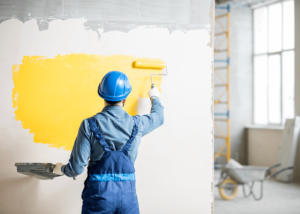Website Development is the process of creating and coding websites and web applications. It includes a variety of essential steps and requires the expertise of an experienced website development team.

First, it’s important to define business and user goals. This will help inform design and layout decisions. It will also influence the content strategy and site map. Visit Us Here for more information.
User experience (UX) design is the process of creating a website that is easy to use and understand. This includes the layout, navigation, and visual elements. UX designers often conduct extensive research to gather insights into user demographics, behaviors, and pain points. This data-driven approach ensures that the design process aligns with users’ goals and needs.
UI design is the tangible part of user experience and covers things like fonts, colours, images, buttons, and other visual elements. UI is important because it can impact user satisfaction and ultimately how they perceive your business. For example, a cluttered and difficult-to-navigate website can be confusing and frustrating for customers. A well-executed UI design is a key component of comprehensive website development that allows businesses to deliver an exceptional online customer experience.
After the UI and UX design has been established, it’s time to start developing the actual website. This is done through a process of wireframing and prototyping, which provides a framework for the website’s structure and functionality. During this phase, web developers work closely with the UX team to ensure that the final product is functional and enjoyable to use.
During this stage, web developers integrate third-party services and libraries to enhance the website’s functionality and user experience. They also conduct testing and quality assurance to identify any bugs, errors, or technical glitches before launching the site. Finally, they perform regular maintenance to address any issues that arise and keep the website running smoothly. This ensures that visitors continue to have a positive experience and drives ongoing business results. The right web development agency can deliver the best user experience for your website. Find an agency that has the technical expertise, innovation know-how, and passion for your vertical.
Front-End Development
The first step of website development involves setting goals and analyzing user needs. This planning stage sets the foundation for a successful web project and helps save time down the line by avoiding potential obstacles from being overlooked or underestimated. It’s important to ask questions like who are your target customers and what will they want from the website. Creating a site map and wireframe during this phase also makes it easy to design the overall look and feel of the site before getting started.
Front-end development is the customer-facing part of a website that includes all aspects from text and colors to buttons, images, and navigation menus. Also referred to as client-side, it’s everything that appears in a browser and is controlled by HTML, CSS, and JavaScript—the programming languages that power all websites. Front-end developers translate design mockups and wireframes into functional, user-friendly, responsive web pages that allow users to engage with brands and products online.
In addition to the standard markup language of HTML, front-end developers are responsible for developing a range of visual elements using CSS and leveraging the programming language JavaScript to add interactivity, functionality, and dynamic features such as animation. They also ensure that all front-end code is compatible across multiple browsers to maximize accessibility and enhance user experience.
As with other parts of the process, front-end developers must adhere to strict web standards and best practices to develop high-quality websites. This includes implementing performance optimizations to ensure that websites load quickly and are responsive to all devices and platforms. This may include optimizing images and videos, caching, minimizing the number of HTTP requests, and using tools to track changes in version control (e.g., Git).
Back-End Development
The back end is the powerhouse of any website. It is what makes web pages and applications work, ensuring security, functionality and scalability. Back-end development involves establishing and building servers, applications, and databases to deliver the information that front-end code relies on. For example, if you’re building a dynamic website that can change content based on user input, you need back-end development to create the server and application that manages the data.
The server handles all the processes of converting data into an HTML page that your web browser can read. This includes querying databases to retrieve information and processing logic that the web application requires. The back-end also ensures that the website can handle large amounts of traffic without running into performance issues.
To do this, the server uses a programming language like PHP to process the data that requests from front-end apps and responds with an HTML page. The front-end then renders the page according to the instructions in the HTML code that is sent by the server.
Back-end development also includes creating and managing databases to store data like user profiles, purchases and other transactional information in a structured and efficient way. It also includes implementing APIs that enable website visitors to access third-party services and features.
As a full-stack developer, you’ll be able to apply what you learn in each of these different areas. For example, you’ll know how to create a responsive and interactive web page that works across different devices. You’ll also be able to design a database structure that’s easy to maintain and secure, as well as how to implement version control systems such as Git to track changes.
Optimizing Website Performance
A fast, functional website provides a seamless experience for visitors and improves user experience (UX). It also boosts search engine optimization as Google and other search engines take page load times into consideration when ranking websites. A one-second delay in page speed leads to 11% fewer page views, lower engagement and 7% loss in revenue.
Optimizing a site includes techniques and best practices designed to reduce load times, enhance responsiveness and improve overall web performance. This typically involves reducing the number of requests made to the server, minimizing the size of resources and leveraging caching solutions. It can also involve refactoring code to eliminate unnecessary functions, minifying files, and using modern image formats like WebP and AVIF.
Rendering performance measures the efficiency with which a browser takes all of the downloaded page components and constructs a finished display for the user on their screen. This can be affected by a range of factors including the quantity and size of files, and network latency. Choosing a content management system with built-in caching and CDN integrations helps to minimize request loads.
It is essential to monitor the performance of a website on an ongoing basis and make changes as required to keep it running at peak performance. This will likely include monitoring the website’s server for issues like excessive load, disk space and memory utilization as well as testing it across multiple devices. It may also be necessary to upgrade the server if it becomes ill-equipped to handle the website’s day-to-day function and traffic levels. Keeping up with the latest web development trends and emerging technologies (like ML and AI) is vital for ensuring that your website remains relevant in the long run.
Search Engine Optimisation (SEO)
A solid search engine optimization (SEO) strategy is a crucial part of Website Development. This involves ensuring that your site is visible to the right people and regularly optimizing it for changes in search engine algorithms. It also involves researching keywords that people use in their searches and incorporating them throughout your site content and structure.
While SEO is an independent discipline, it relies on Web Development to provide the technical foundation for a high-performing site. This includes ensuring that your website’s code is clean and well-structured, with consistent usage of HTML tags and semantic markup. It also includes creating a clear site map and logical page hierarchy that gives search engines clues about the relevance of your pages.
Another vital aspect of SEO is providing relevant, helpful content on your site that answers users’ questions. This helps reduce the reliance on contact centers and other support channels, while also improving user experience by directing them to the information they need quickly.
In the final stage of Website Development, your team attends to the details and fine-tunes the website before its launch. This entails rigorous testing to identify any errors or bugs that need to be addressed before the site goes live. It also involves ensuring that your website is optimised for accessibility, mobile device compatibility and speed. This is where a professional, forward-thinking web development partner really shines. They have the proven technical chops to take a complex project from concept to high-performance reality. And they can help you avoid the costly mistakes that many businesses make when building their own sites. Get in touch today to see how we can help.








